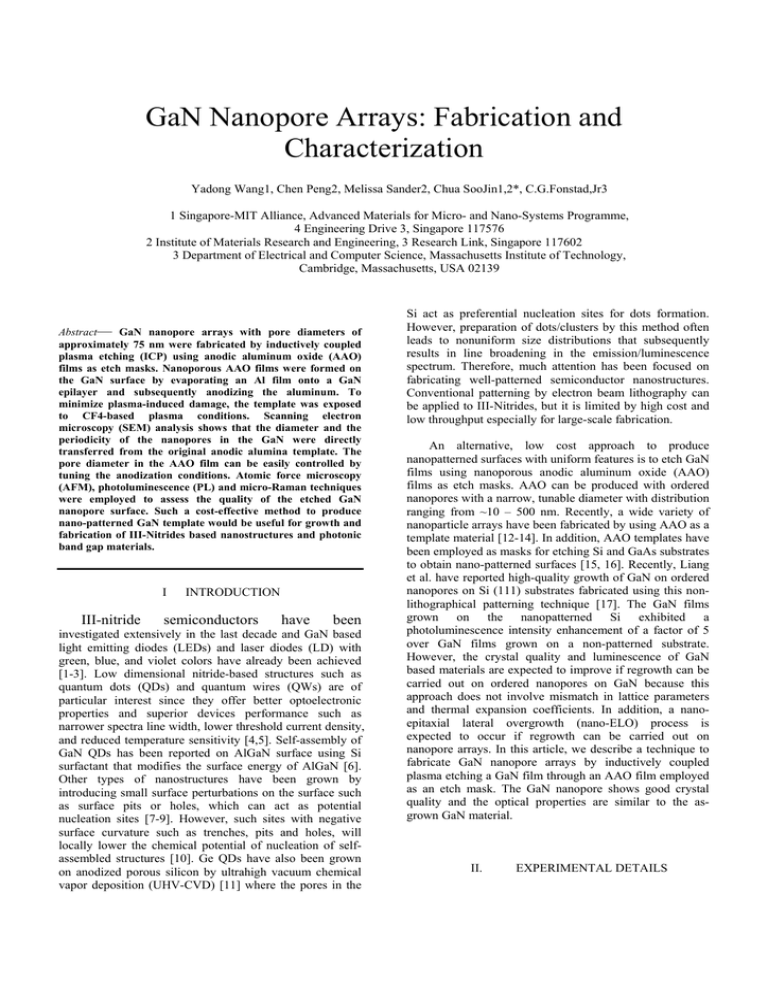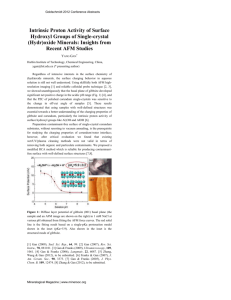Document 11221264
advertisement

GaN Nanopore Arrays: Fabrication and Characterization Yadong Wang1, Chen Peng2, Melissa Sander2, Chua SooJin1,2*, C.G.Fonstad,Jr3 1 Singapore-MIT Alliance, Advanced Materials for Micro- and Nano-Systems Programme, 4 Engineering Drive 3, Singapore 117576 2 Institute of Materials Research and Engineering, 3 Research Link, Singapore 117602 3 Department of Electrical and Computer Science, Massachusetts Institute of Technology, Cambridge, Massachusetts, USA 02139 Abstract— GaN nanopore arrays with pore diameters of approximately 75 nm were fabricated by inductively coupled plasma etching (ICP) using anodic aluminum oxide (AAO) films as etch masks. Nanoporous AAO films were formed on the GaN surface by evaporating an Al film onto a GaN epilayer and subsequently anodizing the aluminum. To minimize plasma-induced damage, the template was exposed to CF4-based plasma conditions. Scanning electron microscopy (SEM) analysis shows that the diameter and the periodicity of the nanopores in the GaN were directly transferred from the original anodic alumina template. The pore diameter in the AAO film can be easily controlled by tuning the anodization conditions. Atomic force microscopy (AFM), photoluminescence (PL) and micro-Raman techniques were employed to assess the quality of the etched GaN nanopore surface. Such a cost-effective method to produce nano-patterned GaN template would be useful for growth and fabrication of III-Nitrides based nanostructures and photonic band gap materials. I III-nitride INTRODUCTION semiconductors have been investigated extensively in the last decade and GaN based light emitting diodes (LEDs) and laser diodes (LD) with green, blue, and violet colors have already been achieved [1-3]. Low dimensional nitride-based structures such as quantum dots (QDs) and quantum wires (QWs) are of particular interest since they offer better optoelectronic properties and superior devices performance such as narrower spectra line width, lower threshold current density, and reduced temperature sensitivity [4,5]. Self-assembly of GaN QDs has been reported on AlGaN surface using Si surfactant that modifies the surface energy of AlGaN [6]. Other types of nanostructures have been grown by introducing small surface perturbations on the surface such as surface pits or holes, which can act as potential nucleation sites [7-9]. However, such sites with negative surface curvature such as trenches, pits and holes, will locally lower the chemical potential of nucleation of selfassembled structures [10]. Ge QDs have also been grown on anodized porous silicon by ultrahigh vacuum chemical vapor deposition (UHV-CVD) [11] where the pores in the Si act as preferential nucleation sites for dots formation. However, preparation of dots/clusters by this method often leads to nonuniform size distributions that subsequently results in line broadening in the emission/luminescence spectrum. Therefore, much attention has been focused on fabricating well-patterned semiconductor nanostructures. Conventional patterning by electron beam lithography can be applied to III-Nitrides, but it is limited by high cost and low throughput especially for large-scale fabrication. An alternative, low cost approach to produce nanopatterned surfaces with uniform features is to etch GaN films using nanoporous anodic aluminum oxide (AAO) films as etch masks. AAO can be produced with ordered nanopores with a narrow, tunable diameter with distribution ranging from ~10 – 500 nm. Recently, a wide variety of nanoparticle arrays have been fabricated by using AAO as a template material [12-14]. In addition, AAO templates have been employed as masks for etching Si and GaAs substrates to obtain nano-patterned surfaces [15, 16]. Recently, Liang et al. have reported high-quality growth of GaN on ordered nanopores on Si (111) substrates fabricated using this nonlithographical patterning technique [17]. The GaN films grown on the nanopatterned Si exhibited a photoluminescence intensity enhancement of a factor of 5 over GaN films grown on a non-patterned substrate. However, the crystal quality and luminescence of GaN based materials are expected to improve if regrowth can be carried out on ordered nanopores on GaN because this approach does not involve mismatch in lattice parameters and thermal expansion coefficients. In addition, a nanoepitaxial lateral overgrowth (nano-ELO) process is expected to occur if regrowth can be carried out on nanopore arrays. In this article, we describe a technique to fabricate GaN nanopore arrays by inductively coupled plasma etching a GaN film through an AAO film employed as an etch mask. The GaN nanopore shows good crystal quality and the optical properties are similar to the asgrown GaN material. II. EXPERIMENTAL DETAILS a c b b anodization process, c) CF4 ICP etching was employed to transfer the pore pattern onto the GaN substrate, d) the AAO template was removed using a chemical etch to reveal ordered GaN nanopores. III. RESULTS AND DISCUSSION Figure 2 shows top view and cross-sectional view SEM images of an AAO template on a GaN/sapphire substrate. The mean diameter of the pores as measured from the SEM is ~75 nm. The interpore distance is ~110 nm. The pore diameter standard deviation throughout the array is less than 10% of the mean diameter as shown in the inset of Fig. 2 (a). The pores are parallel to each other as shown in cross-sectional view. The thickness of the template is ~400 nm. It has been reported that 0.15 µm to 0.5µm thick templates are suitable for the plasma etching process [16]. Figure 3 shows SEM image of the plasma etched GaN after the AAO film has been removed. The pores are perpendicular to the GaN surface and parallel to each other. The pores in the GaN are uniform with an average diameter of approximately 75 nm, the same as the original AAO film. 70 60 Percentage (%) The experimental procedure is shown schematically in Fig.1. The GaN epilayer was grown on a sapphire (0001) substrate using an EMCORE D125 metalorganic chemical vapor deposition (MOCVD) system using a two-step method. Trimethylgallium (TMGa) and NH3 were used as the Ga and N source, respectively. H2 gas was used as carrier gas. First a 30-nm thick buffer layer was grown at 530 oC. Then a 1.5 µm thick GaN layer was grown at 1020 o C. Next an ~1µm Al film was deposited onto the GaN epilayer by electron beam evaporation. Then the aluminum film was subjected to a two-step anodization process in 0.3 M oxalic acid at 2 oC. After the anodization, the template was put into 5 wt% H3PO4 for 75 minutes at room temperature to enlarge the pore diameter and to etch away the barrier layer (for details, see Ref. 18). This procedure allows fabrication with high reproducibility and uniformity due to good adhesion of the template to the substrate. Inductively coupled plasma etching (ICP) was then carried out in a load-locked Plasma-Therm SLR-770 set-up with 2.0 MHz source configured with an electrode chuck in the chamber, which is biased separately at 13.56 MHz. The patterned samples were exposed to CF4/He plasma for 20 mins. The flow rates of CF4 and He were both 20 sccm. The operating pressure was kept constant at 10 mTorr during etching. The inductive power was kept at 500 W at a constant rf chuck power of 150 W. Increasing the rf chuck power resulted in a rough surface morphology. We have found that smooth etched GaN surfaces can be obtained by using the above optimized plasma conditions. After etching the GaN, the AAO film was removed by chemical etching. The resulting nanopores structure on GaN was characterized by field emission scanning electron microscopy (JEOL 6700FESEM). The qualities of the etched GaN were assessed by atomic force microscopy (Digital Nanoscope III AFM), photoluminescence (PL) and micro-Raman scattering. The PL spectra were recorded with a Renishaw 2000 micro-Raman-PL set-up. The 325 nm line of the He–Cd laser was used as a source of excitation. Raman measurements were carried out using the 514.5 nm line of the argon ion laser, where the scattered light was dispersed through the JY-T64000 triple monochromatic system attached to a liquid nitrogen cooled CCD detector. 50 40 30 20 10 0 0 20 40 60 80 100 120 140 160 Diameter of dots (nm) FIG. 2. SEM images of an alumina film on a GaN surface created using a two-step anodization process in 0.3 M oxalic acid at 40V followed by chemical etching to widen the pores and remove the barrier (left) top view; (right) cross-section view. The final template height is approximately 400 nm and the average pore diameter is 75 nm. The pores are parallel and extend completely to the GaN surface. c d Aluminum Alumina GaN FIG. 1 Schematic of process used to fabricate GaN nanopore arrays: a) an aluminum film ~1 µm thick was evaporated onto the GaN layer, b) ~400 nm thick ordered AAO template was fabricated by using a two-step FIG. 3. SEM images of a GaN nanopore array after template removal. (left) top view; (right) cross-sectional view. The average pore diameter is ~75 nm with a depth of ~55 nm. peak was observed from the etched surface. This indicates that there is no significant plasma-induced damage on the surface using our optimized ICP conditions. The surface states responsible for YL are also suppressed. The crystalline quality was further investigated by micro-Raman scattering. Fig. 5(b) shows the micro-Raman spectra from z ( xx) z the GaN nanopore arrays recorded in geometry. The Raman peaks near 568.3 cm-1 and 734.2 cm-1 corresponds to the GaN E2(TO) and A1(LO) phonons. There was no significant blue shift observed for the E2(TO) phonon and the FWHM of the peaks are quite narrow. In addition, no quasi-polar modes appear in the spectrum. Also there was no significant change in the linewidth and peak energy from the etched GaN surface when compared with the as-grown epilayer. Similar to the as-grown epilayer, the etched GaN nanopore shows a component of compressive strain. The absence of disorder-induced Raman bands from the pore arrays indicates good crystalline quality. (a) Intensity (arb. units.) The images in figure 4 show the AFM topography of (a) the initial GaN surface before patterning and (b) the final nanopatterned surface. The roughness of the as-grown surface is about 0.4 nm and defect density is about 108/cm2, indicating the good quality of the starting GaN film. Figure 4(b) shows the 3D AFM topography images of the GaN nanopore arrays prepared by ICP etching. The crosssectional line analysis shows a depth of about 55 nm (average value with a fluctuation ± 5 nm), which is in reasonable agreement with the pore depth determined from the SEM images (Figure 3(b)). The rms roughness of the etched sample is 1.5 nm. Such a small roughness value within the nanopores is reasonable for epitaxial regrowth of nanostructures. As grown GaN GaN Nanopore arrays λexc=325 nm 350 400 450 500 550 600 Wavelength (nm) FIG. 4. (a) AFM image of the as-grown GaN surface. The surface has a step-like morphology and the surface roughness is about 0.4 nm. (b) 3D AFM topography image of GaN nanopore arrays. The cross-sectional line analysis shows a pore depth of ~55 nm. Micro-PL and micro-Raman techniques were employed to characterize the quality of the etched GaN since it is important for the subsequent regrowth. It has been reported that the band edge PL intensity is sensitive to the plasma-induced damage [19]. Fig.5 shows the room temperature micro-PL spectra of as-grown GaN and plasma-etched nanopore GaN after AAO template removal. The near band edge transition in this room temperature PL is observed near 365 nm. No significant change was noted besides a small increase in the full width at half maximum (FWHM) in the etched GaN. No yellow luminescence (YL) Intensity (arb. units) λexc = 514.5 nm E2 (TO) (b) -1 568.3 cm z(xx)z A1(LO) -1 734.2 cm A1g sapphire 400 450 500 550 600 650 700 -1 750 800 Raman shift (cm ) FIG. 5 (a) Room temperature micro-PL spectra recorded from as-grown GaN and nanoporous GaN films. The 325 nm He-Cd laser line was used as a source of excitation. (b) Room temperature micro-Raman spectrum recorded from nanoporous GaN films using the 514.5 nm of Ar+ laser line as an excitation source. IV SUMMARY In summary, ordered GaN nanopore arrays have been fabricated by inductively coupled plasma etching using an anodic aluminum oxide film as an etch mask. SEM results show that the GaN nanopores have a relatively uniform size distribution with an average diameter of ~75nm, which correspond well to the pore structure in the original AAO template. The diameter of the pores in the alumina etch mask can be easily controlled by varying the anodization conditions, including the electrolyte and applied voltage. AFM, micro-PL and micro-Raman analyses confirm the good quality of the etched GaN surface, which indicates that the optimized ICP etching process does not introduce many defects into the GaN surface. This nanopatterning method is a good alternative to lithographic techniques because it is simple and inexpensive and can be employed to pattern large substrate areas. These nanoporous GaN films are potentially useful for regrowth of low-dimensional nitride structures and devices. . REFERENCES [1] S.Nakamura, M.Senoh, S.Nagahama, N.Iwasa, T.Yamada, T.Matsushita, Y.Sugimoto, and H.Kiyoku, Jpn. J. Appl. Phys. 36, L1059 (1997). [2] S.Nakamura, M.Senoh, S.Nagahama, N.Iwasa, T.Yamada, T.Matsushita, H.Hiyoku, Y.Sugimoto, T.Kozaki, H.Umemoto, M.Sano, and K.Chocho, Jpn. J. Appl. Phys. 36, L1568 (1997). [3] S.Nakamura and G.Fasol, The Blue Laser Diode (Springer, Berlin, 1997). [4] Y.Arakawa and A.Yariv, IEEE J. Quantum Electron. 22, 1887 (1986). [5] D.Leonard, K.Pond, and P.M.Petroff, Phys. Rev. B 50, 11687 (1994). [6]S.Tanaka, S.Iwai, and Y.Aoyagi, Appl. Phys. Lett 69, 4096 (1996). [7]R.Leon, R. Leon, T. J. Senden, Y. Kim, C. Jagadish, and A. Clark, Phys. Rev. Lett. 78, 4942, (1997). [8] X.Deng and M.Krishnamurthy, Phys. Rev. Lett 81,1473 (1998). [9] T.I. Kamins and R.S. Williams, Appl. Phys. Lett. 71 1201 (1997). [10] The local chemical potential μ at the surface can be expressed µ = µ + Ωγκ ( x, y ) + ΩE ( x, y ) 0 s as . Here, µ0 is the chemical potential for the unstressed planar surface, Ωγκ(x, y) is the contribution of surface curvature κ where γ is orientation-dependent surface free energy, ΩEs(x, y) is the contribution of the tangential stress, Es is the local strain energy at the surface, and Ω is atomic volume of species. D.J. Srolovitz, Acta Metall. 37, 621 (1989). [11]JY.Huang, ZZ.Ye, BH.Zhao, XY.Ma, YD.Wang, DL.Que, Appl. Phys. Lett. 78, 1858 (2001). [12] H.Masuda and K.Fukuda, Science 268, 1466 (1995). [13] O.Jessensky, F.Muller, U.Gosele, Appl. Phys. Lett 72, 1173 (1998). [14] A.P.Li, F.Muller, A.Birner, K.Nielsch, U.Gosele, J. Appl. Phys. 84, 6023 (1998). [15] L.Jianyu, C.Hope, A.Yin, and J. Xu, J. Appl. Phys. 91, 2544 (2002). [16] D.Crouse, Y.H.Lo, A.E.Miller and M.Crouse, Appl. Phys. Lett. 76, 49 (2000). [17] J.Liang, S.K.Hong, N.Kouklin, R.Beresord, and J.M.Xu, Appl. Phys. Lett 83, 1752 (2003). [18] M. S. Sander and L. Tan, Adv. Funct. Mater 13, 393 (2003). [19] S.Tripathy, A.Ramam, S.J.Chua, J.S.Pan and A. Huan, J.Vac. Sci. Technol. A 19, 2522 (2001).
![Structural and electronic properties of GaN [001] nanowires by using](http://s3.studylib.net/store/data/007592263_2-097e6f635887ae5b303613d8f900ab21-300x300.png)






